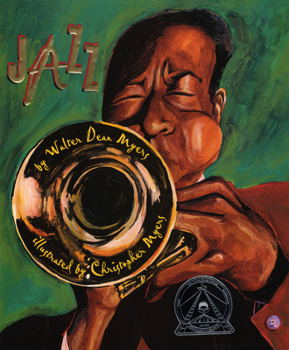Jazz
Select Format
Select Condition 
Book Overview
There's a crazy syncopation /and it's tearing through the nation / and it's bringing sweet elation / to every single tune./ It's Jazz
One of TIME's 100 Best Children's Books of All Time Fifteen poems, infused with the rhythm and wordplay of jazz music, are paired with bold, stylized illustrations of performers and dancers to convey the history and breadth of this unique musical style. From bebop to New Orleans, from...
Format:Hardcover
Language:English
ISBN:0823415457
ISBN13:9780823415458
Release Date:September 2006
Publisher:Holiday House
Length:48 Pages
Weight:1.40 lbs.
Dimensions:0.4" x 9.7" x 11.6"
Age Range:8 to 12 years
Grade Range:Grades 3 to 7
Customer Reviews
4 ratings
The book is the music
Published by Thriftbooks.com User , 14 years ago
I checked this book out from the library and I love it. Whether you look at the pictures or read the poetry you will feel jazz. The illustrations are intense, vibrant, energetic, playful. Each picture is accompanied by a poem (or more). You will hear jazz when you read the poems. If you are a musician, you must need to make jazz when you read these. Included are an introduction about the history of jazz, a glossary of jazz terms and a list of important dates and events in jazz history. I could only wish for a few white people in the book. You know we like jazz too.
book review
Published by Thriftbooks.com User , 15 years ago
Very nice illustrations. It is more of poetry than a story about jazz, but I do appreciate it. I'd read this with probably late elementary age kids.
Lovely & Lively--a great teaching tool
Published by Thriftbooks.com User , 17 years ago
This book is a true find! I'm a teaching poet in the schools and this handsome book with its truly musical poetry helped me when teaching jazz--and jazz poetry-to elementary school kids. The sophisticated poems (some of which address separate elements of jazz including the different instruments) read rhythmically in a way that delights when read aloud! Highly recommended!
A clarinet sassing its way through a Sunday-night sermon
Published by Thriftbooks.com User , 17 years ago
Okay. A bit of a confession here. Back in 2003 I wrote a review of "Blues Journey" in which I said many nice things including, "This is the book that took my breath away", which is fairly expansive even for me. Three years have now passed, and what father/son team Walter and Christopher Myers did for the blues they are doing now for jazz. Looking back on "Blues Journey", I realize that at the time this was not a book I was particularly good at understanding. I had the wherewithal to know that it was beautiful, but if you asked me the number of times I've thought about "Blues Journey" in this three year interim, the answer would be hardly at all. "Jazz" is different. I know it sounds unlikely, but I think this book has something its predecessor lacked. "Jazz" has a purpose, defined by its dedication ("To the children of New Orleans") and brought to searing sizzling life by both its author and its artist. No one can tell you after perusing this book that "Jazz" isn't hot as all get out. An introduction. For two green pages we are given some facts before the fancy. What is jazz? Where are its roots? How did it grow, prosper, and come to flourish? Where is it today? That's a lot to slip into two little pages, but before you know it you've learned a fact or two and on you go to the poems. They echo what we've just discovered about the music itself. You're looking at a man, bare to the waist, beating out a rhythm on the drum just in front of him. Now it's a black silhouette of a piano player poised against a shifting deepening red background, lit from below. We're in New Orleans following a jazz funeral, then looking down on a charismatic keyboardist with a zoot suit of fine scarlet lines. Beautiful women croon to men curved over, above, and around their instruments. It's jazz, baby. With a glossary in the back and a timeline for kicks. Right off the bat I'd like to thank Mr. Myers senior for explaining something to me in his lengthy two-page Introduction that I didn't even know I didn't know. The birth of jazz: how did it happen? The answer can be found in a small selection at the bottom of the first page. "Since so many black musicians were still not formally trained in reading musical notation, there had to be some way of knowing what the other players were going to do so that they could perform together". So they used common chord structures that would allow them to "stray from the melody" and come back to it howsoever they were inclined. You would think that your average twenty-eight-year-old American would have picked up this kind of information somewhere amongst their various meanderings. Not so much. To Mr. Walter then, a debt of gratitude. Music related books for youth, be they picture books, novels, or comic books, have the awesomely difficult task of conveying an absent sense through words alone. Sometimes a picture might help, but it is the rhythm of the words that keep the toes tapping and throat humming.




